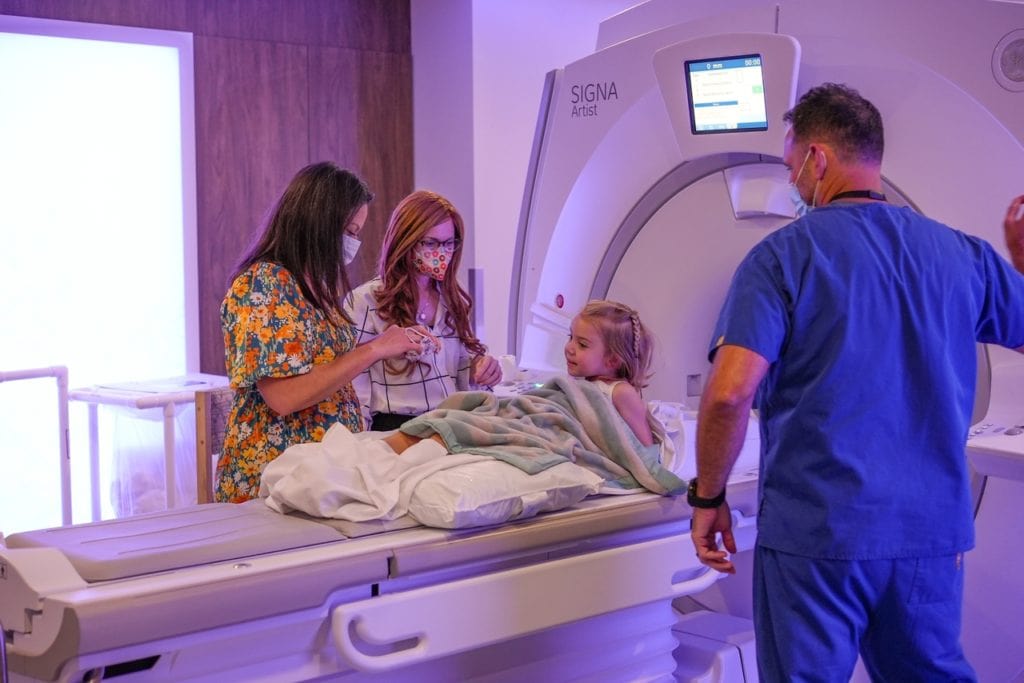MRIs are Scary. So New Hanover Medical Center Came Up With a Plan for Kids

Ally Chartier’s mom gets the first word in this story about how Novant Health New Hanover Regional Medical Center in Wilmington, North Carolina, is helping children get through an MRI.
“For me, as a mom, these situations are so difficult, overwhelming, larger than life,” said Laura Chartier. “For them to make it so much easier, that you are part of a village and they are the village, there is not a word I can find that expresses what it means.”
What leaves Laura and her husband, Matthew, speechless is a new initiative that helps children undergo an MRI with less fear and no anesthesia. That includes Ally, 5, whose procedure came with a bonus. She got to watch Disney’s animated “Vampirina” as she went through the machine, then take home a teddy bear and “Frozen” coloring book.
The New Hanover program is STARS – Supporting Try Awake Radiology Scan. By explaining the procedure so kids can understand it, and offering perks like video goggles to watch movies, children ages 7 to 12 can more easily complete an MRI without sedation. Since STARS started in March, only one of 100 patients in the program required anesthesia.
That makes for a safer procedure. “Sedation carries a lot of risks,” said Dr. Andrew Wallace, a pediatric radiologist who performs MRIs at New Hanover. It also makes for a more effective procedure. Wallace said less nervousness on the part of the child typically means less squirming during the 30- to 40-minute procedure. That makes for a sharper image for physicians to analyze.
An MRI, or Magnetic Resonance Imaging, provides three-dimensional images to help detect, diagnose and treat diseases. Wallace said most MRIs for children capture images of the brain, often to determine what’s causing seizures, headaches or fainting spells. Most of us can picture the intimidating-looking machine. Think a tube or tunnel. Some kids say it looks like a doughnut. Some of us have gone through one. All of us can sympathize with the child for whom the “tunnel” awaits.
Alicia Cesare, a child life specialist at New Hanover who oversees STARS, said the program tries to do what might seem impossible – make an MRI a less daunting experience.
The mission begins with the medical team learning as much about each child as they can, both their medical condition and background. Then, in a subsequent telephone conversation, a team member walks families through the MRI. They review what the machine looks and sounds like. They’ll ask whether the child has an aversion to noise. Wallace said an MRI emits loud sounds for which the patient wears headphones to soften the sound and hear their movie.
Ally’s mom said the initial conversation took fear of the unknown out of the equation. “They let us know a literal play-by-play. They spoke with words of kindness and respect,” Laura Chartier said, noting that Ally wanted to be in on the conversation. “She’s full of fire and spirit. She wanted to know what was going on.”
The goal is to make each child feel part of the team. “They are participating in their own care,” Wallace said. “They cooperate. They know what to do.” The end result? “They hold still.”
The day of the procedure, children arrive to find toys in the waiting room, including teddy bears (when available) they can cuddle with during the MRI. They get to select music or a Disney movie or TV show from the hospital’s impressive collection. “A treasure trove,” Cesare called it. Nothing makes an MRI go faster than watching an awesome movie or show on video goggles. The Caring MRI Suite, used by children and adults, offers music, videos and a panel that allows children to choose their favorite color with which to light up the room. The New Hanover Regional Medical Center Foundation raised $170,000 to bring the suite to life.

When it’s time, a parent or caregiver is an arm’s length away. Children are given a ball to hold tight. A child can squeeze it for whatever reason, alarms go off in the control room and the technologist can stop the exam and see what the issue might be.
And when the MRI is over?
“I love seeing that ‘aha moment’ with children and families,” Cesare said. “That they were able to say ‘I did it!’ It will help them with coping skills the next time they have to go to a physician or hospital.”
Ally’s MRI was July 13. Laura said it was quick and easy. Then she shared the best news of all. Everything on the MRI looked normal.
With all due respect to Mom, the last word goes to Ally.
For this “interview,” the rising kindergartner held court from her car seat on the way home from Costco. Yes, she enjoyed “Vampirina.” No, she wouldn’t like to have another MRI. But because of STARS, here’s the kicker. Ally told her mom to tell the reporter that she’d do it again if she had to, like the brave 5-year-old she is.
Want to help?
Donations of teddy bears and other children’s items – new and in their original packaging – are welcome. Visit nhrmc.org/ways-to-give for a list of what’s needed.